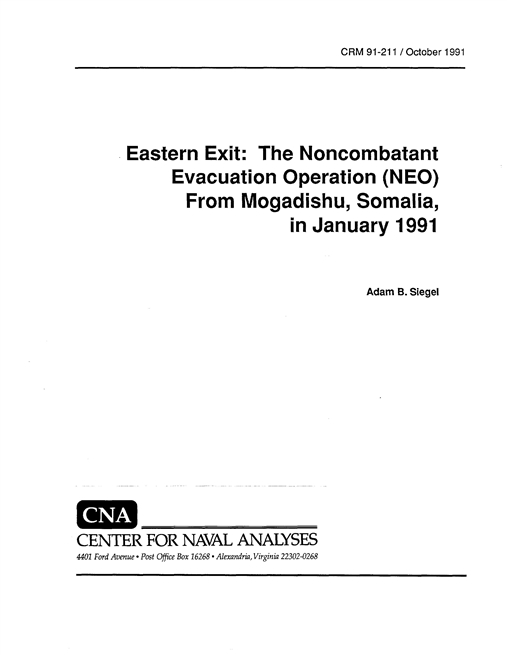In early January 1991, U.S. military forces executed Operation Eastern Exit, a non combatant evacuation operation (NEO) of the U.S. Embassy in Mogadishu, Somalia. The primary forces involved in this ten-day operation were U.S. Navy and U.S. Marine forces diverted from Operation Desert Shield.
Eastern Exit received relatively little attention as it was conducted on the eve of the war with Iraq. In other circumstances, the execution of such a short-notice and high-risk operation might have garnered front page headlines around the world. Noteworthy items included the evacuation of 281 people from over 30 nations, including 12 heads of diplomatic missions and 39 Soviet citizens from amidst a bloody civil war.
The military operation itself might seem more like a Hollywood script than reality. Little over two days after leaving the North Arabian Sea, USS Trenton launched two CH- 53Es with a 60-man combined SEAL and Marine evacuation force. The launch occurred in the middle of the night, over 450 miles from Mogadishu. En route, the two helicopters conducted two nighttime aerial refuelings (though none of the pilots had exercised this for over six months). On arrival off the coast, the two CH-53Es descended to 25 feet and sped over the city, landing in the Embassy compound even as looters were at its walls.
The 60-man evacuation force quickly moved into fighting positions to protect the Embassy and the two CH-53Es soon took off with the first 61 evacuees. Despite intennittent harassing fire, the evacuation force held its fire during the 17 hours it spent on the ground. U.S. forces took advantage of night vision devices and conducted the final evacuation in the middle of the night via ten CH-46s operating from USS Guam.
A close examination of this operation leads to a number of valuable lessons-both positive and negative-of value for future NEOs. Eastern Exit was clearly a very successful operation. Following are some of the reasons things went so right.
- The results of MEU(SOC) training can be found throughout Marine Corps and Navy amphibious forces. While the NEO force was not a MEU(SOC), MEU(SOC)-developed SOPs greatly aided planning. The previous MEU(SOC) training of many Eastern Exit participants aided the execution of the operation.
- Desert Shield training had raised the forces to a high level of preparedness.
- U.S. Navy and Marine cooperation was close-knit, to the point of having a common command space and, essentially, a combined command staff.
- Unlike many other NEOs, the U.S. Ambassador had a clear understanding of his role. He had the Embassy organized for an evacuation, maintained a clear picture of the situation on the ground, and clearly expressed his intentions and orders to the inserted evacuation force. It seems plausible that the Ambassador's previous experience with NEO operations (including involvement with the first several months of Operation Sharp Edge, the NEO from Liberia) contributed to his actions during Eastern Exit.
On the other hand, a number of problems call into question the means by which the military and State Department prepare for and execute NEOs.
- The information on the U.S. Embassy in Mogadishu possessed by the mission's forces was dated and inaccurate. Among other problems, the two CH-53Es had to fly over embattled Mogadishu for 20 minutes searching for the Embassy compound. A regular review of information provided to amphibious forces should be conducted at U.S. Embassies. On the basis of the Eastern Exit experience, it seems clear that the means by which basic NEO information is prepared and distributed deserves review.
- While the civil war in Somalia intensified rapidly, nonessential personnel were evacuated from the Somalia several weeks before the amphibious forces in the Persian Gulf were appraised that a NEO via military forces might be required. The State Department should request that the military commence NEO planning as soon as the decision is made to evacuation nonessential personnel (if not earlier).
- The ability of the Embassy to facilitate a NEO was deficient in several potentially vital areas. There was no direct secure communications capability between the Embassy and the evacuation forces (the only means to directly communicate was via an unsecured radio). The Embassy had minimal capabilities to mark a landing zone for rescue helicopters Gust a strobe light and someone waving a white flag). Secure voice capabilities between military forces and an Embassy during an evacuation are vital. Common cryptologic material for NEOs should be promulgated, and these codes should be distributed to Embassies and deployed military forces. Means to mark helicopter landing zones should be maintained at every Embassy, possibly by the Marine Security Guard detachments.
- Some links of the chain of command did not receive orders and information on the seriousness of the situation on the ground in Mogadishu. This led to orders that delayed the movement of amphibious forces south. The chain of command must be delineated so that involved commands will not be acting on the basis of incomplete information.
These are some of the more vital lessons from Operation Eastern Exit. This research memorandum documents Eastern Exit and highlights issues raised during it.
Download reportDetails
- Pages: 65
- Document Number: CRM 91-211
- Publication Date: 10/1/1991
